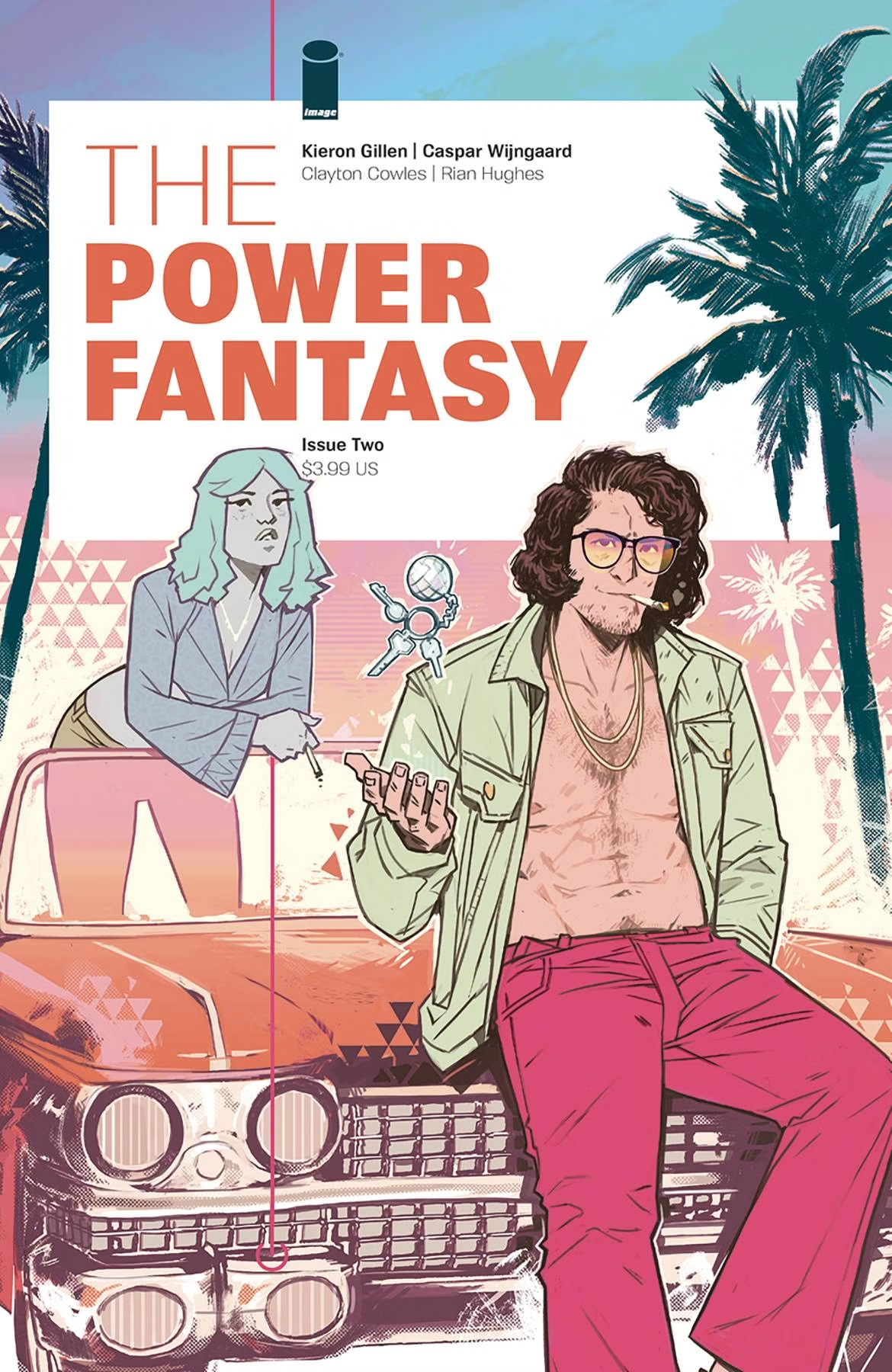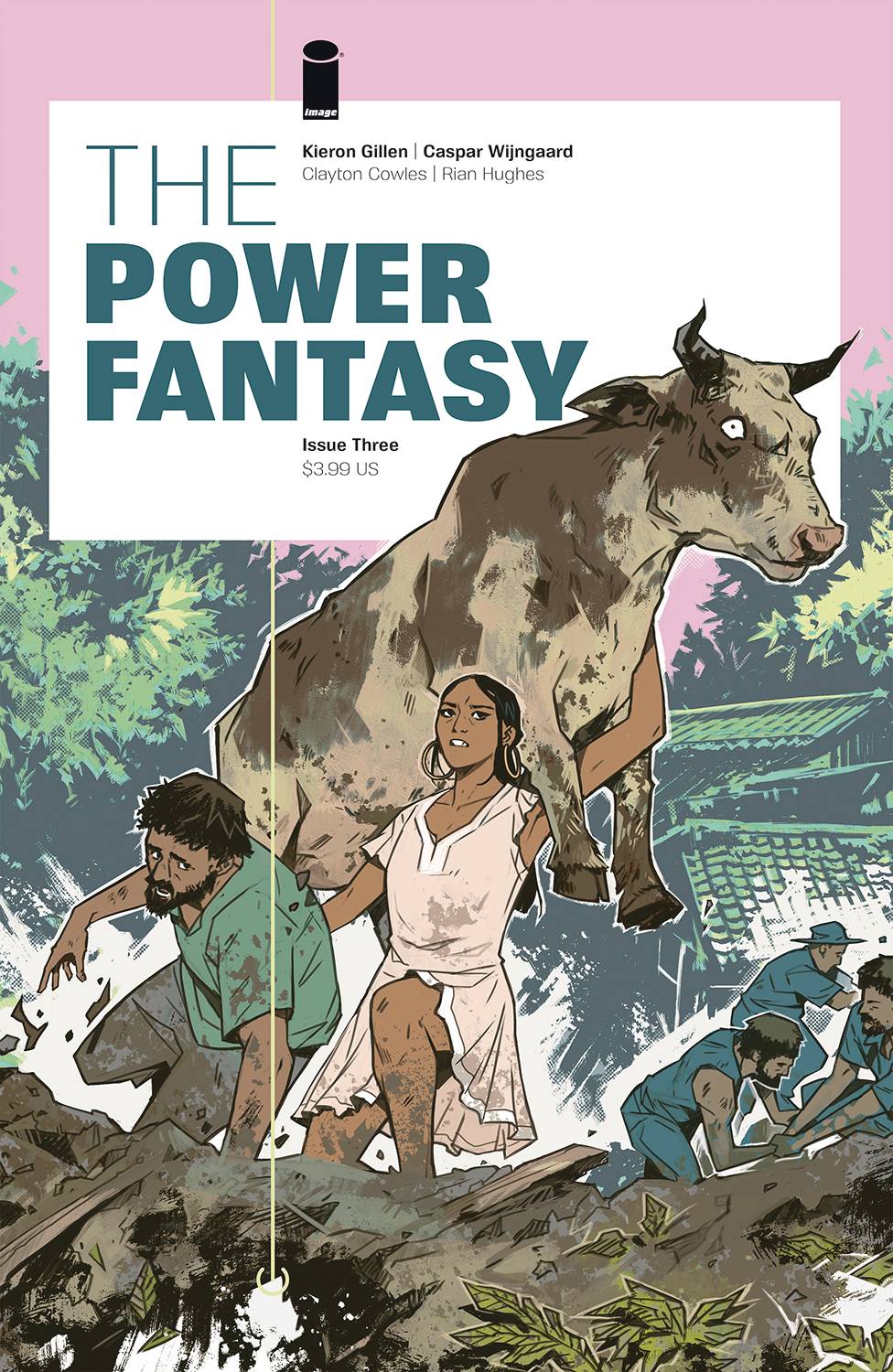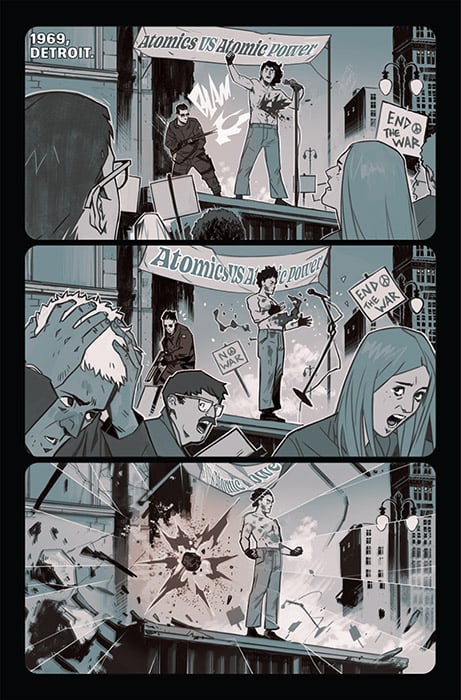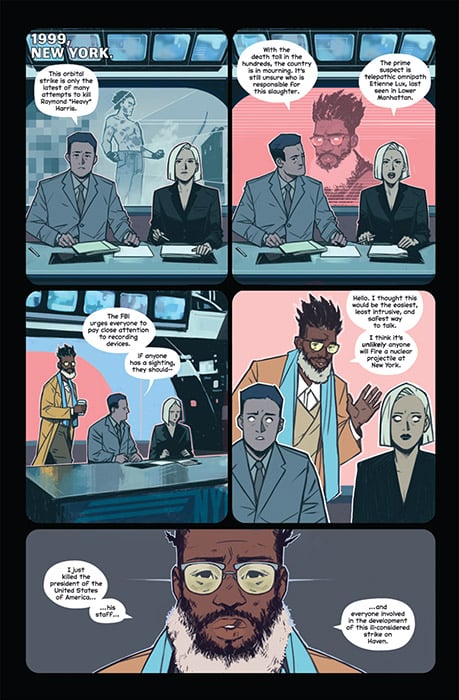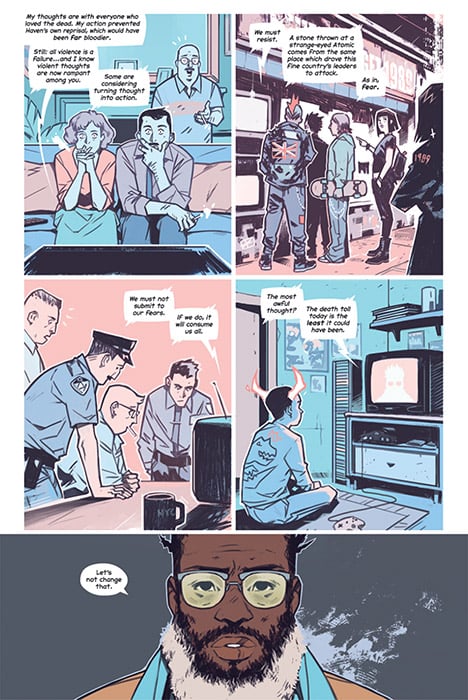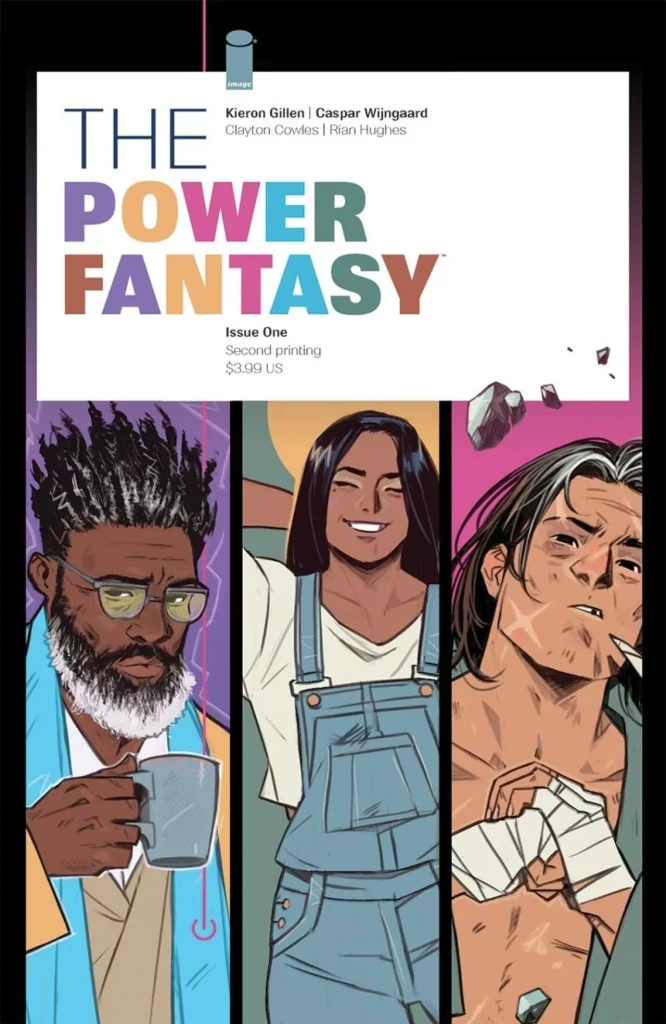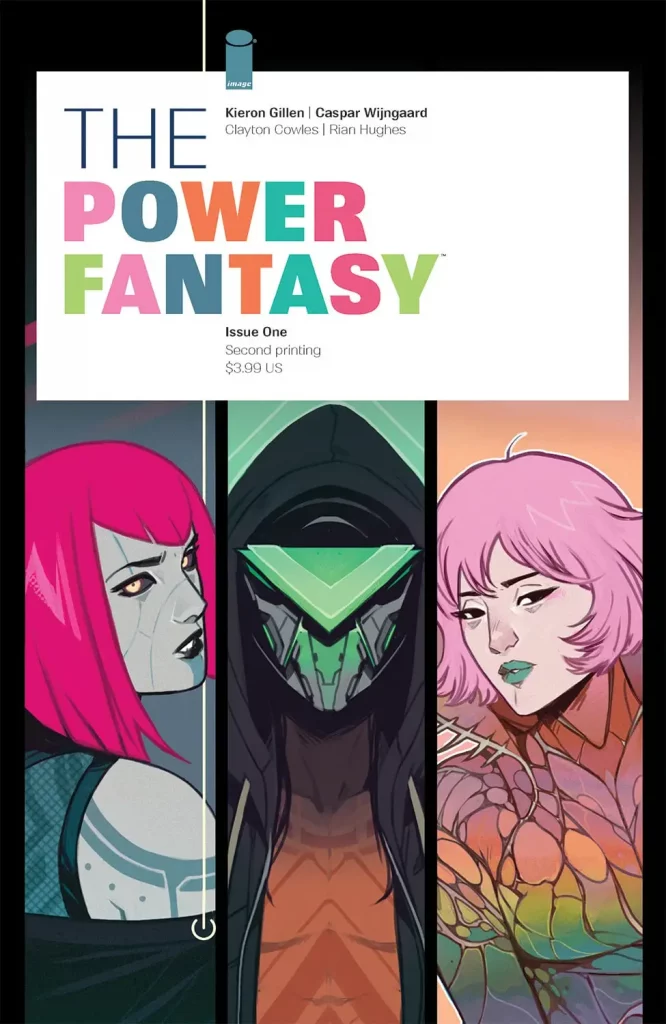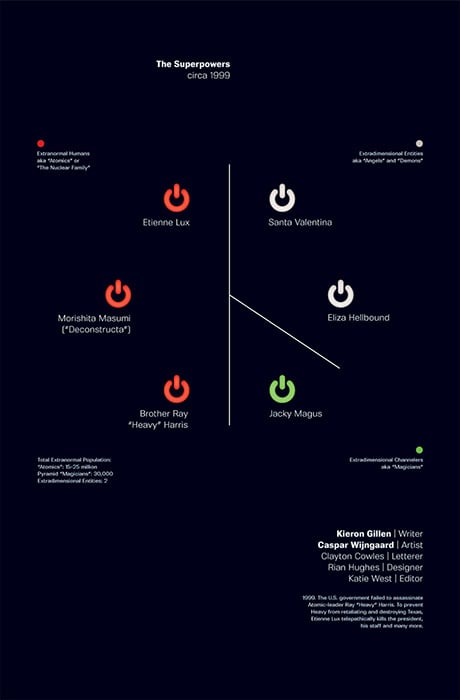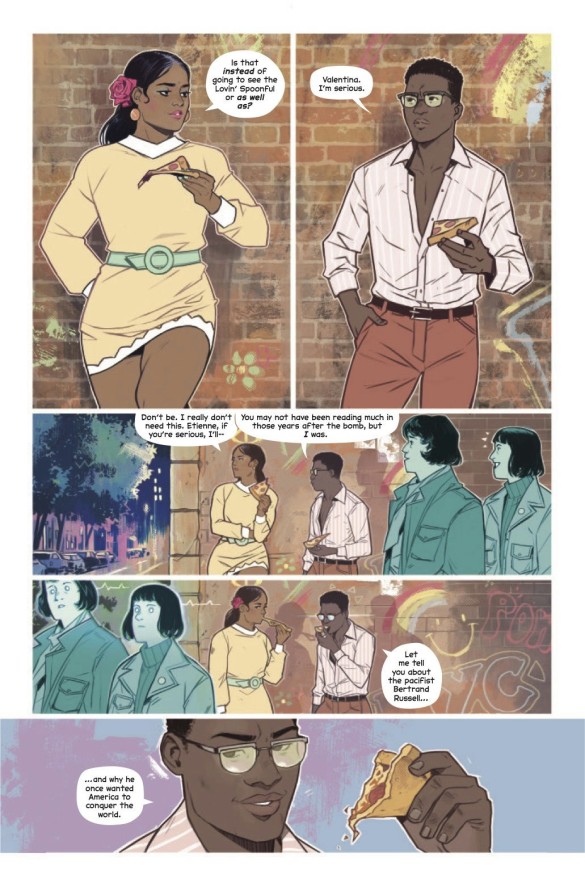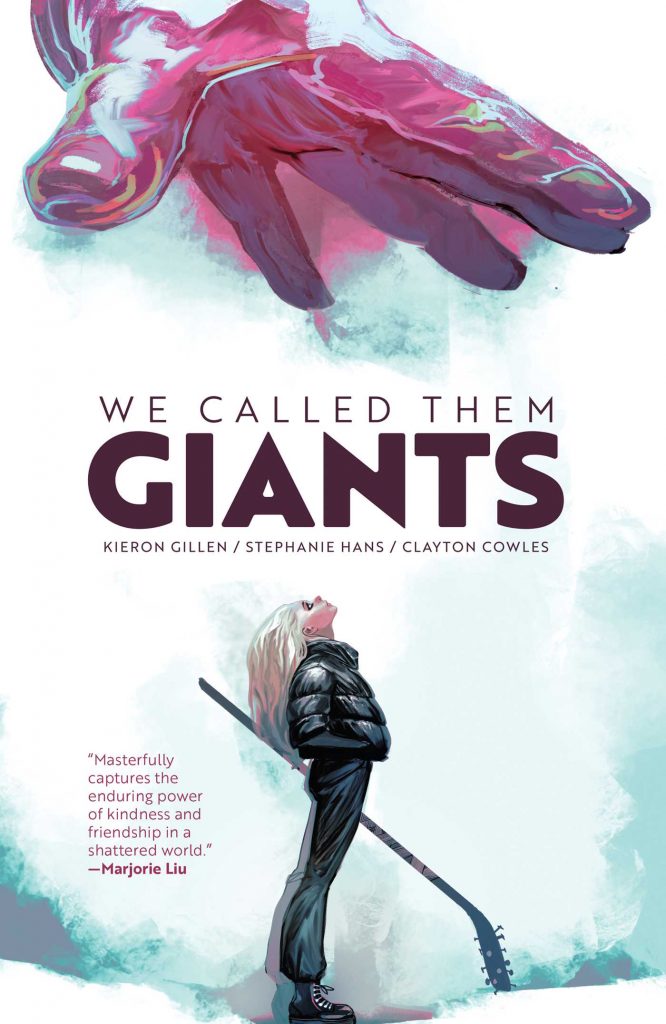Ooooooh Atomics!: Kieron Gillen on the Past, Present, and Future of The Power Fantasy
Kieron Gillen is always building.
Building on his ideas. Building on his previous work. Building on what his collaborators bring to the table. You name it. And The Power Fantasy — his new Image Comics series with artist Caspar Wijngaard, letterer Clayton Cowles, and designer Rian Hughes — might be the biggest thing he’s built yet. It’s a sprawling story set across 54 years in the 20th century, an alt-history tale that explores what would have happened if The Atomic Age that started in 1945 also included the arrival of superpowered individuals. Or, to be more specific about its core conflict, here’s how the solicit to the first issue described The Power Fantasy as.
“‘Superpowered.’ You have certain preconceptions. They’re incorrect. Here, that word has a specific technical definition. Namely, ‘any individual with the destructive capacity of the nuclear arsenal of the USA.’ There are six such people on Earth. The planet’s survival relies on them never coming into conflict.”
It’s an incredible concept, one that has a staggering amount of potential both in terms of the impact the story could have and the depth the creative team could bring to it. But as these superpowered individuals prove in the series, while potential means a lot, the thing that really matters is what you do with it — and the team behind The Power Fantasy is building something special here. I’ve now read the first three issues, and each is better than the last. The story only gets richer the more that’s revealed and the more questions that are asked. And because it’s such a dynamite read — and one that I was barely able to touch on when I talked with Gillen on Off Panel earlier this year — I had to know more.
So, I did what I could to do just that. I recently hopped on Zoom with Gillen to have a sprawling conversation about all things The Power Fantasy, including Wijngaard’s genius, Hughes’ impact, how Gillen thinks about story on a micro and macro scale, the cast of the series, their approach to superpowers, the alt-history aspect, the challenges of publishing a comic right now, and a whole lot more. It’s a dense and interesting conversation that’s absolutely about The Power Fantasy, but it’s even more about how Gillen does what he does. That said, it does include some spoilers for the first issue if you haven’t read it, so beware!
You can read it in full below, as it’s open to non-subscribers. However, as per usual, if you enjoy what you read and want to read more like it, please consider subscribing to SKTCHD. Your subscription gets you access to all the work I do while funding these efforts, ensuring they can happen at all.
We were recently talking over email about Kelly Sue DeConnick and David Lopez’s FML and the idea of opening movements in comics, and I was thinking of that while I was driving and listening to Spoon’s album, Ga Ga Ga Ga Ga, and how that balances tempo and poppiness and everything well across its 10 tracks.
You think a lot about music. You think a lot about comics. When you’re doing a creator-owned book, like The Power Fantasy, do you think about story and issue sequencing in the way a band might think about an album? Where you need to not just have individually effective tracks, but ones that fit well together and deliver different feelings and experiences each time to some degree?
Kieron Gillen: The answer is, “It’s complicated.” Like most things. I always think about how issue two of Hawkeye is what (Matt) Fraction wrote first. The idea that, “No, this is a good issue, but it’s not issue one.” The thing of an ongoing book, for any story of any size, is how to explain it. I’ve written essays about issue ones, because issue ones are the one most people have written the most of. Especially by definition, you’ve written more issue ones than anything else unless you’re a fill-in writer. A lot of issue one is, “So, what do we have?” and a lot of issue two is, “Well, what else do we have to say? What is necessary to be told immediately and what can actually wait a bit? So that’s at least building the world, building what you’re doing, building the toolkit, building audience expectations.
And the other side is the journey of it. “Okay, what goes well together?” In the case of The Power Fantasy, I’m coming from a mixture of quite a traditional perspective, as in the stuff I have experience in, and stuff where it’s like, “Okay, this is what I’ve got.” I’ve committed in a much bigger…not even a bigger way, but I committed to, “The first real movement is 15 or 16 issues.” So, I’m committed to that. No matter what, that’s where we’re going, and then we’ll see where we’re going next. And since that’s unnegotiable, what do you need to introduce?
And then almost every issue, I have so much material because we’ve got 54 years of story. What’s actually needed to tell a story? And a lot of writing The Power Fantasy now is, “What’s the story here?” As in, what’s interesting? How can I keep people interested in stuff that’s already in play? And how can I grow it and show the other stuff we’ve got going? And doing that in a 20-page comic is brutal. It’s a cast of six, and the thing is once they’re introduced, they’re also in play then, so it needs more spin to keep them going. So much writing longform is plate-spinning.
I only realized that, oh yeah, Eliza Hellbound is cameoing until probably issue six. By issue five, she’s there in quite a big way. But she’s a mysterious figure. (laughs) And it’s like, “Well, I guess she’s the mysterious figure,” and she maybe wasn’t that in my initial conception. But the second you’ve got this one piece, it makes so much other stuff have to be there.
Do I mechanically plan it? The answer is, “Kind of.” You can see we do this thing at the end of issue three where we’re making promises that we’ll have to fulfill – and to do that, we have to have a rock-solid plan, at least enough for that. But it’s still got so much room for play inside.
Part of the reason I thought about this when I was listening to that album was, I was thinking about the fact that the first really pop track is You Got Yr. Cherry Bomb at track three. And then I thought about the fact that on a lot of albums, the first song that’s kind of designed as a single will be number three. And the third issue of The Power Fantasy is when the story really hit me the hardest. The first issue sets things up, the second issue continues that, and then with the third one, I was like, “I can see the potential of everything.” It was the You Got Yr. Cherry Bomb of the Power Fantasy, and that struck me as interesting.
Kieron: It’s the panoramic pullback. Issue three was originally going to be issue two. It’s the Valentina issue. It’s a fairly deep dive on her. There’s still obviously more to say, and that was issue two. And of course, what my realization was issue one has so many promises about momentum, so we have to follow that through for people.
We can spoil issue one. The president’s dead. I can’t just leave that hanging and go into a flashback across 50 years or whatever. Well… I could do that. I don’t think it’s wise. I think issue one makes promises and we have to pick up on those promises. And also you get stuff like, if we’re going to have Etienne going to Tokyo for Masumi’s launch, we need to sort of justify that. Why on Earth is Etienne doing that?
So, you have to know more about Masumi, so Masumi has to be in issue two as well. Issue three is, here’s a great time to pull it back in. As in I can tell the story because we’ve done two issues of driving the core plot. Now we can do something that absolutely does forward the story slightly…but does something else too. It definitely moves on, but it’s really about digging and saying, “Let’s pull back and give the scale.”
Die was almost quite similar in some way. We’ve got this issue one where we explained the concept. Issue two where we develop it and show the different modes of story. Then issue three is when we did the Tolkien issue, and it’s showing, “Oh yeah, we’re also doing this.” And I hope Power Fantasy is better, in some ways.
The other thing in Die is kind of completely and utterly separate to the story. We’re doing these Planetary-esque looks at fantasy tropes, and we’re also doing a personal drama. They’re the two strands of Die and that’s what makes it run the dichotomy.
The Power Fantasy’s strands aren’t separate. This is like, “Oh no, it’s still one story, but the story’s much bigger than you have any idea of until this page.” I mean, you probably get an idea. It’s not like we’ve been shy about name-dropping all the stuff that’s already happened, but issue three is like, “Oh, no, it’s significantly different. All this stuff is here.” Also, issue three is showcase for Caspar. When I saw what he did, particularly with that issue, I was like, “Oh, I can do more of this.”
Issue four’s script is significantly different than the earlier issues’ scripts. In three, he does these sequences as he’s going through time. It’s stuff I’ve talked about in interviews earlier in terms of what we want to do, and that’s visible previously. But issue three is where, “Oh no, he’s really doing it now.” The 1950s in Toulouse, 1 for example…that’s just beautiful. When he’s doing 1969, that’s got the dark end of the hippie vibe, and so on and so forth.
I know you’ve worked with Caspar before, but do you feel like as you see pages coming in, you better understand how far you can push things with him? And maybe you start changing things because of that? Because you’re like, “Oh, this shot of Valentina doing X, Y or Z is so great, so now I know that he’s got that in his bag.” Does that open things up as you move forward in the Power Fantasy?
Kieron: Yeah. Especially the technical tricks in that aspect. I’ve worked with Caspar before, but that was several years ago. He’s changed as an artist since then.
And Peter Cannon is a way different book.
Kieron: Exactly. I want to say Peter Cannon was the last go at me writing The Wicked + The Divine. It is a formalist book and it is especially about me and my formalism. And WicDiv was me and Jamie (McKelvie) really showing what we could do. We were intense and the scripts were dense technical beasts.
With Power Fantasy I’m explicitly not. I’m not even seeing roughs. Caspar just shows me finished pages, and then he’s quick enough to redraw if there’s a major problem. But I’m very into him taking lead instruments in this form. I give ideas in the script. I give shape. I give structures. There’s stuff he does in issue three which I pick up on issue four. And say, “Hey, how about having this visual motif running through the issue separate to the actual story?” and leaving it to him to interpret. That kind of stuff.
Fundamentally, I’ve done WicDiv. I don’t need to do WicDiv again. In fact, WicDiv again would be bad for me. Instead, I can actually spend my time on everything else. And the thing about Power Fantasy is there so much of everything else. We drop a timeline in issue three. God bless John Hickman. (David laughs) Hickman’s quote was “care that borders on being obsessive,” and he could see that in issue one that, “Kieron doesn’t say things like this without knowing what it is.” Few people’s compliments are like John’s. John sees what we’re up to, so he sees what I’m up to as a creator.
But me spending so much time there instead of the wanky stuff I normally do is interesting. WicDiv, though, is kind of like Young Avengers, but really WicDiv was, “I want to make Jamie a star.” And what that really means is, I want to create a place for him to do what he does and make everyone realize, “Fucking hell, look at this guy.”
Caspar’s really good. I don’t think he’s had enough eyes on him as he should have, so giving him as much space to go as wild as possible and push his interests. So much is just not doing the same thing again though as well. So that’s how I keep myself interested. Also, he’s inspiring. I see something (Caspar does) and think “Okay, why not this?” Because that’s the other side. You talk about the structure. I have firm ideas of what’s going to happen here, but I’m discovering a lot of the story by writing.
Because like you say, you’ve got 54 years of history. What do we show when? There are certain things where I know, ” This is important. It has to be here.” But other stuff is like, “Okay, when do we show this? What do we reveal? And also in 20 pages, what cast do we have?” I only realized in the process of writing issue four that it’s about Magus and Heavy. Specifically, it’s about men and cults. And I realized that’s the comparison there. That’s interesting. I knew what would happen… but writing showed me what it was really about.
And of course, Magus is the guy you probably hate by issue five. You probably hate by issue three. You probably hate by issue one. (laughs)
The easy comp for him is Woden. But at the same time, I know you don’t want to do the same thing again. Jacky Magus is going to be a dick, but he reads way differently than Woden. He’s not mean-spirited in the same way, or at least not so far.
Have you read Cixin Liu’s Remembrance of Earth’s Past trilogy? The Three-Body Problem books?
Kieron: I’ve only read the first one. Which I loved.
In a strange way, The Power Fantasy reminds me of that trilogy. Especially when I got to issue three. There was a specific word that shows up in the third issue. Deter. (Kieron laughs) Deterrence is a massive part of that trilogy, in the sense that much of what that series is about is deterrence and the neutralizing power of strength. And it thrives because it takes what is a far-fetched, hard sci-fi concept incredibly seriously. That’s what you’re doing here too, and it makes it a lot more interesting to me. We haven’t seen that done a whole lot. It’s like what you say in the back of issue two, “We’ll turn fighting into the lose state.”
Is it more fun for you to write a superhero story where fighting is not on the table, where deterrence is important, where all these things that are not normally superhero type turns are present? Is that more fun for you to write in some ways?
Kieron: It’s certainly what makes the book novel. I’ve written a lot. It is a book in a tradition. Without a doubt, you can put this book in a tradition of comic books that take superheroes relatively serious. There’s lots of different ways of doing that. This is probably closer to the WildStorm end of things. That’s the obvious comparison, and it’s not wrong. But you’ve got the other side, the Vertigo side, something like Enigma, which takes superheroes very seriously but is a phantasmagorical piece on sexuality.
So, I think…not my weakness, but my thing as a writer generally is I take shit too seriously. I have a sense of humor, which is a big part of me. But my other thing is, “Let’s really think about that for a second. What would that be like?” I don’t just mean cynically either. It’s the positive side too. I remember the first panel of Young Avengers in the preview story was America Chavez flying. Jamie and I spent a lot of time working out how can we make the flying feel like flying. Because flying is a miraculous, wonderful thing and it’s turned into just a verb in a superhero comic. We wanted to really think about flying, what it’s like to do that, and try to get a panel that sums it up.
That’s kind of The Power Fantasy taken to the extreme degree in terms of, “Let’s talk about if people are that powerful, what happens?” I often say, and it’s in the back matter as well, but I say, “I kind of semi-object to the word ‘superhero’.” Not because I don’t think it is informed by the genre, I just worry that we’re selling it wrong. (laughs)
It’s taking superheroes and turning it into a science fiction idea. Let’s take this novum of an idea which is, “These people are powerful enough to destroy the world. Let’s dig into them and take that seriously and follow the extrapolations out.” That gets to a place quite rapidly that uses a lot of superhero grammar but without actually giving you any of what it normally does.
Ironically, saying that makes me think of Young Avengers. I was very conscious about removing the middle in that series. I described Young Avengers in a music metaphor as all treble and bass. The mid-tone of what superhero comics normally run off, the plot engine stuff, I cut. We cut past all the fight scenes almost. We cut past adventures, and we go to the bar afterwards and show the kissing and the deep structure.
So, by removing what is normally most of what makes a superhero book work creates a different mix. In this case, we removed the fights part of the genre. That’s like a lot of the shows I like. I love Shogun. I finally started watching Shōgun recently and I was all in only two episodes in, which is where I’ve stalled, because of toddler life. These people are all smart, trying to get what they want, bumping heads trying to work out that stuff, and they’re trying to avoid the obvious, because war is bad. (laughs) They all know war’s bad, they don’t really want to have war at this point. And that really appeals to me.
I just felt like there was space here for a good story, and one I haven’t seen. Therefore, if I’m interested in that, other people will be too. And I think that’s what everyone does of course is this steamroller of, “Okay, this is how things go, this is how they go badly, and this is what they do and now we’re going to fall out of this murder.” And so, then introducing all the rest of the cast.
I think issue one’s a machine whilst issue two is softer. It feels very human. And then we go from there to all these different aspects. I mean, (there’s a scene of) Heavy and Tonya just having eggs. That kind of shit. I just want to take it seriously, but also humanly. There’s a scene I’ve just written, a bit of the timeline where a lot of people die, and the scene is immediately after that. And I have to rethink this scene through the filter of the size of the carnage to try to treat it seriously.
Because at least part of it is the idea that the level of death is too big to imagine. And then also earlier, there’s a bit where a character kills a person in the timeline. And I’ve written that murder and I’m like, “Oh no, reread that.” It was like a Millar-esque someone saying a badass line. That would’ve gotten a pop.
But that’s not what it is.
Kieron: Yeah. He could say the line, but everyone will say, “Oh, for fuck’s sake, man.”
I just have to take it seriously and give all the characters interiority. This sounds incredibly basic but try to strip away the tropes as much as you can whilst also having fun with it. For example, I think Etienne is my picture of how fun a telepathic character could be.
I also love the fact that he is constantly saying, “That would be unethical.” He has this specific code that’s so basic and it makes him really fascinating, even as a little kid. Well, spoilers, I guess. I shouldn’t say that.
Kieron: I mean, it’s told across 54 years. We’ve told people we’ll do the timeline so people will see him, I guess.
I do want to say: superhero is the wrong word. Superpower is the right word.
Kieron: Oh, absolutely.
Saying the former word is doing the series a disservice. The latter word is accurate.
But we talked about the lengthy timeline before when you were on the podcast. Seeing how that impacts society and pop culture and politics and journalism and all these different things, it’s more interesting to see that in application than in theory. I’m not saying that you’re going to tell us whether the Backstreet Boys became popular in 1997 or something like that. But it is interesting to see how these superpowers shape the world. It becomes an alt-history story where you get to explore all this to an extreme degree.
Kieron: It definitely is for me.
If you gave me twice as many pages, I would be talking about the Backstreet Boys in this period. (David laughs)
I’m sorry I went with the Backstreet Boys. That’s where my mind went first.
Kieron: Oh no, it’s set in the 1990s. One of my favorite character designs is a character who has a nu metal look in issue two. There’s nothing that’s not funny about that. (laughs) Caspar doing 1999 nu metal. I would do so much with that. I mean there’s stuff like…what’s Valentina listening to?
The music of the future.
Kieron: Yeah, exactly. The music of the future…but what is it? “Fuck, it’s a Phonogram Kieron Gillen bullshit bit.” We do all this stuff, but the actual biggest problem of doing The Power Fantasy as an alternate history at this moment is so it doesn’t divulge too fast. I realized basically with the existing six superpowers, the world would skew off to the left way too fast. So I needed something to stop it going left, otherwise the world would be unrecognizable by 1999. You start with Valentina, who is a classic non-interference kind of superhero character. She’s the closest you’re going to get to a superhero in the book. Then you get Etienne, who can’t do half the shit he wants because Valentina will kill him. So immediately you’ve got those two balancing.
Then you’ve got Heavy, who changes the dynamic. Imagine if the American radical left in the 1960s had that level of power, you know what I mean? That they could make real demands and have to be listened to? That’s going to change things hard. So, I had to add something to stop it just spinning off too far whilst of course still spinning off a bit. (laughs)
A lot of it is the great joy of eventually dropping a timeline in the book. And the joy of that is timelines are fractal. I’ve got the big changes, but the more you look at a timeline, the thinner the gradations. There’s an amazing game called Microscope, which is all about that. At the beginning of the game you can say, “This is a story about the rise and fall of the Empire of Vidargy-barg.” So you all know you’ve got rise of the empire at the start and the fall at the end. Then there’s a system of inserting events into it, like halfway through there’s contact with Martians. And then three quarters of the way through, Martians cut contact. Then it’s the Martians’ final battle against Vidargy-bargians and so on.
You add events to the timeline and create a story because you’ve got a beginning and the end. You know where you’re going, but you can always add more and more fine details as long as it doesn’t disrupt anything on the bigger scale. And that’s like The Power Fantasy. I keep on looking and realize, “Oh no, something else, something else, something else.” And that’s currently what I want. I always have a high-level structure, but the more I look at the characters, the more I discover small things. And that’s quite hard.
How would this end? To choose one thing, how would this impact their space race? Who lives? Who dies? Does that make sense?
Absolutely.
You’re talking about how they would naturally shift to the left. When you’re developing the characters — especially because of the word deterrence…I really do think deterrence is going to be an important word for this series going forward — do you have to think about them in a balanced sense? Do you have to develop their personalities and their characteristics in a way that naturally balances each other out?
Kieron: One part of it was world-building, but the other is thinking of it as drama. These characters aren’t actually surrogates for nations, or a big metaphor. The idea is almost the opposite. As in, let’s take these people with their beliefs and different ways of looking at the world and do a drama about them. They’re just people with the power of nation-states. So imagine me and you are given the power of a nation-state. I’ll tell you what, there’ll be a lot more Stilt-Man comics suddenly, right?
Hell yeah.
Kieron: And Kenickie will probably reform, in my case. Let’s give these people very individual worldviews, this level of power, and see what happens. And then I look at things like the balance. And as I said, I realized, “Oh no, the balance has shifted to left.” We’ve got Valentina, who’s a classic liberal do-gooder, but you’ve got Etienne who doesn’t really want to rule the world particularly. I mean to us he does, but Etienne’s real thing is, “Can we just avoid killing each other?”
That’s his primary goal. Etienne would change a lot, I’m sure, because he’s very rational, and that’s a loaded word. But even without that, he’s still got his identity: he’s black man from France…you know what I mean? There are certainly things he would do, in his own way, even without taking over the world. We’ve got Heavy who is hard left. I wanted more of a full-on radical character – and that he’s a little more loose cannon says something about him too. Then, we’ve got Magus. The core of Magus was he’s a sell-out. By the time we’re joining him in 1999, he’s become someone else. His ethics have significantly altered from his early, 1970s days. That’s kind of why he’s a heartbreaker.
Then you’ve got Eliza, who’s quirky. Eliza is deeply religious and has her very own weird moral kind of structure. She’s the ultimate expression of my Catholic torment character. It’s Lucifer in 1373, Exodus, all those people. Let’s look at Catholicism one more time. That’s a good example. And Masumi, who is just trying to get through the day, and how can you be an artist with this level of power? She’s almost a classic WicDiv character. She has her art, and she has her demon, and her demons could kill everyone.
All of them are based around ideas. I should say explicitly that Etienne is an end’s-justify-the-means guy. I’ve done several of those characters and normally things end badly for them. There’s something about utilitarianism I find fascinating, especially when you get to the scale of nuclear war, you end up with the awful mechanical calculus. I don’t know if utilitarianism works very well on a small level and I don’t think it works on a high level in that way, because what happens if you’re wrong?
These are all kind of characters designed to explore ideas I’m interested in and then go for it. So, there’s balance on some level, but it’s also kind of what’s cool? I mentioned stuff like The Signal. The Signal could have been one of the seven and they’ve ended up moving into a different place. The Queen’s been mentioned a few times. The Major has been alluded to too.
There are more ideas, and I edited it down to a useful six. And six is still a lot to run a drama off, especially now they’ve got a supporting cast as well, which is kind of also important for the book. There’s sort of an irony in Power Fantasy. It’s a “superhero comic” with the most powerful characters, and there’s probably still more normal humans in it than the vast majority of normal superhero comics. We’ve got a supporting cast, we’ve got people who aren’t these people. It’s important.
You have the Atomics too.
Kieron: Oh yeah.
Who do you think my favorite character is after reading the first three issues?
Kieron: What a good question. Let me look at you in the eye. Who’s got stilts? You’re not a one-note guy, don’t worry Dave.
I guess the first who gets most play is Etienne. Etienne’s sense of humor shows up in issue two a lot more. I think some people who were turned off Etienne in issue one, might be going, “Actually, I kind of get him.”
I would guess Masumi.
Valentina.
Kieron: I should have guessed Valentina, for fuck’s sake. Of course you’re Valentina. If you’ve already read issue three especially, I think you get the sweetness of her. Valentina and Etienne were the first two characters I made up. I saw them both quite cleanly, especially them eating pizza. That was the core image. But yeah, she’s a sweetheart.
Why didn’t I say Valentina? Clearly, you’d be Valentina.
I am the person who played Knights of the Old Republic, the Star Wars game…I don’t know if you ever played that.
Kieron: I have, yeah.
Your decisions affect where you end up on the dark or light scale. I was, and I’m not even kidding, 100% light. I somehow managed to play the entire game without getting a single demerit on the dark side. That’s very Valentina.
This is a complete aside. I lived with five guys across two apartments in college and we all played the game at the same time, and it was an accurate representation of our personalities in terms of how dark or how light we went. It was a fascinating experience.
Kieron: That’s funny. My housemate, Dan Griliopoulos, who is an ex-games journalist and now a game developer…I played it first because I was reviewing it and he played it second. I went full light side. He went full dark side. And he didn’t go out of any desire. He felt quite bad for most of it. (laughs) Of course, “Kieron did it this way, I’m going to have to see the other content.” So it was solely for curiosity, which also says something about Dan, I think.
It’s a fascinating game too, because the person who had by far the easiest time in my friend group was the person who went 100% dark. I feel like that says something and I don’t know if I like it.
Kieron: You can imagine I have alerts set up with Power Fantasy stuff. It means that occasionally I see stuff where people have used the phrase the power fantasy in a different context. That Ozymandias moment 2 where he’s looking at the monitors, I’m getting a bit of that, which is kind of the point of the word. The name is used all over the place but seeing how people use it is interesting.
There’s one Tumblr thing that turned up, which was someone saying, “In a game when you can do anything, why are you still good?” And someone said, “Why? Because the power fantasy is that I can be as good as I want and there’s no reason not to be.” And that first person just really didn’t get it.
But the older I get, the more that’s true of me. When I’m playing a role-playing game, I play as a paladin. It’s not actual paladins but people who literally are just good people and they’ll be as good as they can, no matter their consequences. And it’s quite telling that the older I get, the more I like Superman essentially.
But yes, Valentina is that. She’s our Superman. Also, she’s tall. See: Stilt-Man. I should have guessed Valentina. She’s the tallest member of the cast.
There is a shot in the third issue where she has reached peak Stilt-Man status. (Kieron laughs) I very much appreciated it.
But The Power Fantasy as a title…it’s such a good title. I know it wasn’t its first title, though.
Kieron: The Superpowers was first.
That would’ve been a good title. The Power Fantasy is better. That’s because it’s so interpretive in the same way that your Google Alerts are. That makes a big difference, because while Valentina is my favorite right now, I bet if you ask me in 12 issues, I have a different number one. That’s because peeling back the onion helps you better understand the situation and the context. I’m not saying I’m going to be like, “Oh, Jacky Magus, that’s my guy.”
Kieron: Maybe so.
Maybe when I see the cold, dark rationality of capitalism, I’ll be into Jacky.
Kieron: I hope so. I really like multi-leveled characters. The idea that these are a group of people that I’m going to explore and we’re going to learn to love them and hate them and see their triumphs and failings. For the sake of everybody, I hope they overcome their desire to destroy the fucking world. And as you say, you’re right. The title is useful because the title is meant to be interpreted. And that means, “Okay, what’s this about?” And it’s, “Be alert.”
I quite like the Rorschach test of it, as a book. It has been interesting because some reviews or even commentary around has about which character they think is the villain. (laughs) Or “Who do you think is the villain?”
Can I ask you a better question?
Kieron: Please.
Is there a villain?
Kieron: That’s what I mean. I don’t want to say that in that way because just I don’t think so. I don’t really write villains. I write people who make terrible errors. But people have selected different people as the villain, and it says much more about them than I think the book.
Has the consensus formed around Etienne and Heavy?
Kieron: I think so, yeah. But the reasons are interesting. There’s an Oscar Wilde line I always paraphrase. “All criticism is autobiography.” That’s what I always bear in mind when people respond to a book, because that’s what it is. It says, “You think this, and it says where you came from as much as anything else.” But I’ll say there’s room for everyone to be monsters or heroes or angels.
Did you learn anything from The Pantheon of The Wicked + The Divine that led into how you developed these characters?
Kieron: Good question. My basic structure for doing ongoing works was kind of solidified in WicDiv. The way that WicDiv worked was I have a larger structure, as in I know what happens at the end of every trade, and I also have material. The material being the personality details. I know everyone’s backstories, failings, and mostly where that takes them.
Therefore, where I reveal stuff about people and their stories and their failures and flaws can be sequenced throughout the whole stories of the Pantheon. That’s kind of how I did it. I did it on Die as well and I’m doing it here. I think Die as a midpoint is interesting to look at as well because WicDiv was a much broader, sprawling thing with a lead character.
And Die is a traveling party.
Kieron: Yeah, and Die is six people. There’s a note there. If you want to do the actual deep character work, you need to cut the cast down. You can do a different sort of story with a bigger cast, but if you want to do the interactions between them, you need to have less parts of the system. The system’s too complicated if you have 13 people all arguing. You need to have these poles which you can move stuff around.
Another thing about Die I did was I made the characters twice as complicated. With WicDiv, every character apart from Laura had a single hamartia. This is their problem. This is the thing that’s broken about them. And with Die, I made everyone have two major things going on, at least. Look at Ash. Ash had her issues involving children and gender, and these are two completely separate stories which intersect because people are complicated.
And the lesson I learned from Die is almost going back the other way a bit. Power Fantasy characters are a little simpler because I think Die would feel slightly too compressed, especially because I was doing the entire history of RPGs at the same time. So to give more space, the characters have been drilled down to a core idea. That’s what I think I’ve got back to WicDiv in terms of, let’s take the lessons I learned about drama from Die and the lessons I learned about iconic characters from WicDiv and bring them together.
That’s what I think The Power Fantasy does.
I feel like a lot of people look at The Power Fantasy as purely a response to your time working with the X-Men, but it’s really a response to everything you’ve done before.
Kieron: Yeah. It’s a story. We talked about this on the last podcast, but there’s a journey. Yeah, it absolutely comes from Immortal X-Men, but Immortal X-Men came from Die. In fact, actually Die and WicDiv beget Eternals and Immortal X-Men. (laughs) In fact, Eternals influences Immortal X-Men, Die especially influenced Eternals. There’s a journey of thinking. I’m going to write this in one of the essays, but I found myself thinking, “Oh, there’s a completely different version of The Power Fantasy I could have written. Let’s take some incredibly normal people and just give them the ability to destroy the earth. One day they wake up and find themselves with this power, and that’s a very different story.”
That would’ve been The Superpowers.
Kieron: Yeah. It feels more like a novel.
With The Power Fantasy, I was interested in the taking some of the conventions and the visuals of the superhero comic and applying them to this story. There was part of that there. There’s a conversation. There’s a journey. How do to phrase this? I like to imagine…I know it’s not true, but you mentioned Spoon earlier, the band aspect, to me. In terms of, “Hey, you can start here and follow it through.” It’s the same way you can listen to Bowie. Listen to all of Bowie’s album, there’s a story there implicitly of, “Okay, now I’m going to Berlin to be a bit weirder. Now I’m going to go try to do one that sells.” (laughs)
And also, what they’re interested in and where they are. I talk about the (A History of Rock Music in) 500 Songs podcast a lot, which is great. But the thing you get from that are the stories behind the records. Not just the making of stuff, but also these are people. This song by The Beatles was a direct response to this song on Motown. And you can see the conversation and the joy of it. And it’s something I hope people see with me. It’s a story and I hope it’s a compelling one.
But yes, I think is it just I’m a dog on my bone and chewing away on my obsessions. I’m interested in complicated, messy people having bigger, high stakes arguments. I want to find devices to turn the drama up on that. I am always gnawing on my big themes, and that’s obviously how the stories we tell ourselves influence ourselves and how they can be mistaken and manipulate us. The stuff I got from 1984, basically. My formative interest in Situationalism, all that stuff. There’s also, can we change? We are fallen people. Can we transcend? Which is absolutely my Catholic upbringing mugging me. (laughs) And my stories are all different ways to talk about it.
I heard Kelly Sue talking on the recent podcast about her being a better writer now. I think I’m a better writer. I’m not as good at some things and there’s certain things you can only do as a young writer, but in terms of just the basic human stuff, the idea of thinking about people and understanding people, I think that’s there now in my work, beneath the cynicism and whatever else there is in it. I love people. They break my heart.
How do you make all that fun for Caspar to draw and fun for readers to read? Because that’s the thing that makes people want to dig into all that.
Kieron: I’m attracted to artists who are also storytellers. Caspar clearly should be writing his own comics. Stephanie (Hans) wants to do her own comics. Jamie obviously did eventually. I like people who really commit to the story rather than anything else. So Caspar will make anything look good. (laughs) There’s a bit of that. I’ve been around the block enough to know, “Okay, if this is a talkie scene, how can I make it interesting? What is the draw? What’s the cool little moment you’ll get?”
There’s a scene in issue two that’s a telepathic conversation between Etienne and Masumi, and she’s in Tokyo in the morning and he’s in New York where it’s raining. It’s just him getting out of the taxi and beautiful. What’s the shot? A page of him being tense in the shadows whilst Masumi kind of disassociates a little. These are quiet scenes, but they’re beautiful ones and they’re pure comics. There’s a page I’ve just got from issue four where things get really tense, and I’ve just forwarded it around to all my friends. This isn’t a talking scene. It’s a couple of words. But it’s interesting to draw because it’s dramatically loaded and has things that are good to look at but are not necessarily just punching.
In issue three where you’ve got the bit with Etienne and Valentina meeting as children. It’s in Toulouse, and he’s done it in a beautiful way. He’s made it visual because he’s interested in it. They go for a walk, they go to a park, they sit on the swings. And these incredibly powerful people who are children sitting on swings…that’s a compelling image. It’s stuff like that. And there’s a part in issue five where characters are just having a conversation on rubble.
Some of my favorite bits in Judgement Day like Captain America and Jada 3 are just sitting at the end of the world having a coffee and trying to just chew over something. And that is compelling. It’s compelling because it’s quiet at the moment compared to everything else. And a good visual doesn’t have to mean something is exploding. It definitely can. (laughs) And you know Caspar will do a good explosion.
There is part of me that just goes, “Okay, is there enough volume in this book?” The issues all have volume in different ways. All of them have that kind of, “Oh, right. That moment we’ll be able to cut out and use as a reprint cover.” There’s always something which can be taken out and put on the cover if we wanted to. In issue one we had several. We’ve used Heavy being blown apart as an reprint cover. We are probably going to use the Valentina as an angel as a reprint cover if there’s a fourth printing.
At this point you’re going to have to use a lot of things because you keep going to more printings.
Kieron: If we have a fourth, we’re going to have to start thinking about a fifth as well. I’m pretty sure we’ll go to at least a fourth. So, all of that, “What can we use for a cover in an interesting way?” Not that I’m thinking of them as covers. I’m thinking about that kind of visual hard-hitting stuff to make people go, “This is the kind of an image that’s going to show you all some shit.”
But Caspar will make the less awesome shit amazing to look at too. I’ve just written a page where Magus slaps someone on the back of the head, and that’s going to look amazing. That’s pure cartooning. A beautiful piece of cartooning is also beautiful. It’s like Calvin and Hobbes. Calvin and Hobbes isn’t all dinosaurs.
If you ever go to multiple prints on the third issue, you have to use the final page.
Kieron: That’s a good one.
It has to be.
Kieron: The data page. (laughs)
(David laughs) No. The final art page that Caspar draws. I mean a data page isn’t a bad idea either.
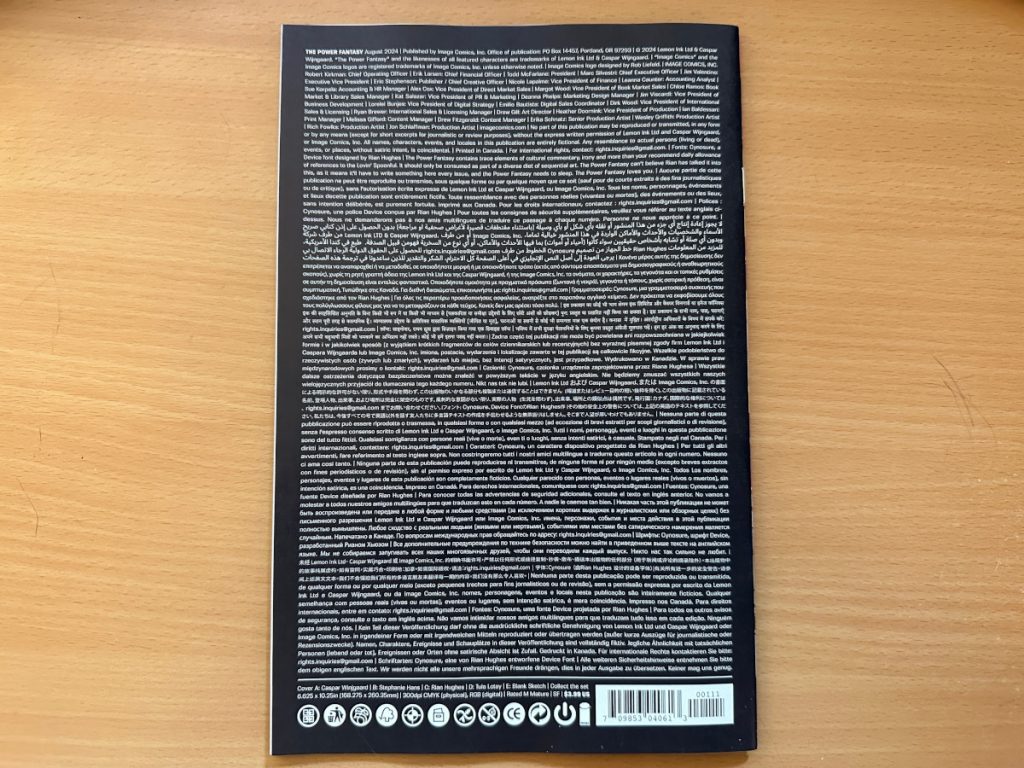
That gives us a chance to talk about Rian Hughes. One thing I love about this book is when I read its first issue, it felt like a complete package where every part was considered and fine-tuned to be this single comic book package. Including the giant indicia, which I wrote about and you kind of made fun of me for, but whatever.
Kieron: It’s a lot of fucking work. I’m glad someone noticed it.
But the second and third issues have essays from you, the second has an interview with Pornsak Pichetshote about The Horizon Experiment, and the third has a thing I love in it. It’s further reading section of your and Caspar’s respective works. I’m sure part of it is, “We want to make this worth it for readers.” But it all feels like a snapshot of who you and Caspar are and who the team is and what you’re trying to build in this in a cohesive way. I don’t even have a question. I just think that’s impressive.
Kieron: Yeah. I’m not someone who gravitated towards single issues when I came to comics. I was a trade guy. So I’m aware that if I’m going to do single issues, I’m going to have to really make them single issues. These are beautiful aesthetic objects. In the same way I bought singles as a music fan, what can we do to make them feel really their own thing and beautiful and interesting and worth collecting? I plan for the trade too, but every one of these issues ends in a big beat. I hope people are going to go, “Oh, what’s next?” It’s the Saga model, essentially. We’re not going to waste your time. We’re going to have cool shit every issue. All that’s tied in, and it’s aesthetically pure.
And Rian…Rian is full of so many ideas. We had huge PDFs of ways we could have taken the cover. We have significantly more radical covers we didn’t use, we’re likely going to use some of them elsewhere in different ways. But there’s the idea that you can flip and see the back cover and immediately go, “Oh, it’s The Power Fantasy.” And one of Rian’s ideas was the on/off button as the symbol, which took me a while to warm to. I was a bit worried because I thought people were just going to think Dr. Manhattan.
I did.
Kieron: Yeah. I mean, less people have than I thought they would actually. But I came around to it for various reasons. Not the least was the slight cheekiness, but I’m kind of hot and cold on that. But the symbology works well, and I love the enchanting of the world. The idea that if you see a power on/off button, you might think of The Power Fantasy if it got big enough. And it’s just a fun icon.
All these aspects Rian has made combine together and we kind of just get bigger and bigger. Not too much, as you said – but enough. We’re not doing that many data pages. Only if I have to. There’s not one in issue four, for example.
Only if it’s additive. That’s the thing I like about the ones you did. They hit at the right moment and expand what you know without telling you too much. They’re informational and teasers. That is a fine line you all walk well.
Kieron: Definitely. In terms of the one in issue two, explicitly…there were regularly reviews that got the terminology wrong for the characters, and it was because we hadn’t explicitly done a diagram. We think it’s probably worth giving, “Okay, this is the difference between an atomic. And what was an atomic? Valentina is not an atomic.” That kind of stuff.
We’re dropping into the world and keeping it very natural, and it’s probably actually worth making sure everything is aligned, even though the book does explain it as it goes along. It’s just really intricate. There’s also lots of new information, as you say, and people will make assumptions. And then with the timeline in issue three, it’s like, “What do we not show?”I wrote up a full detail one just so Caspar could see it, and then I’ve started editing from that. But the one you’ve read won’t be the one people see. There’ll be a few changes, with perhaps even a couple of things removed. But it’s a teaser, the shape of things to come.
We were thinking about just blacking out some stuff (in the timeline). But that’s what the Krakoan Era did, so no. Also, I feel half the time we didn’t know what was beneath them. I just love the idea of going the other way and going, “In issue seven we’ll do this. Issue 13 we’ll do this. Come at me, bro.”
You have to deliver, though.
Kieron: Trust me. I am petrified. (laughs)
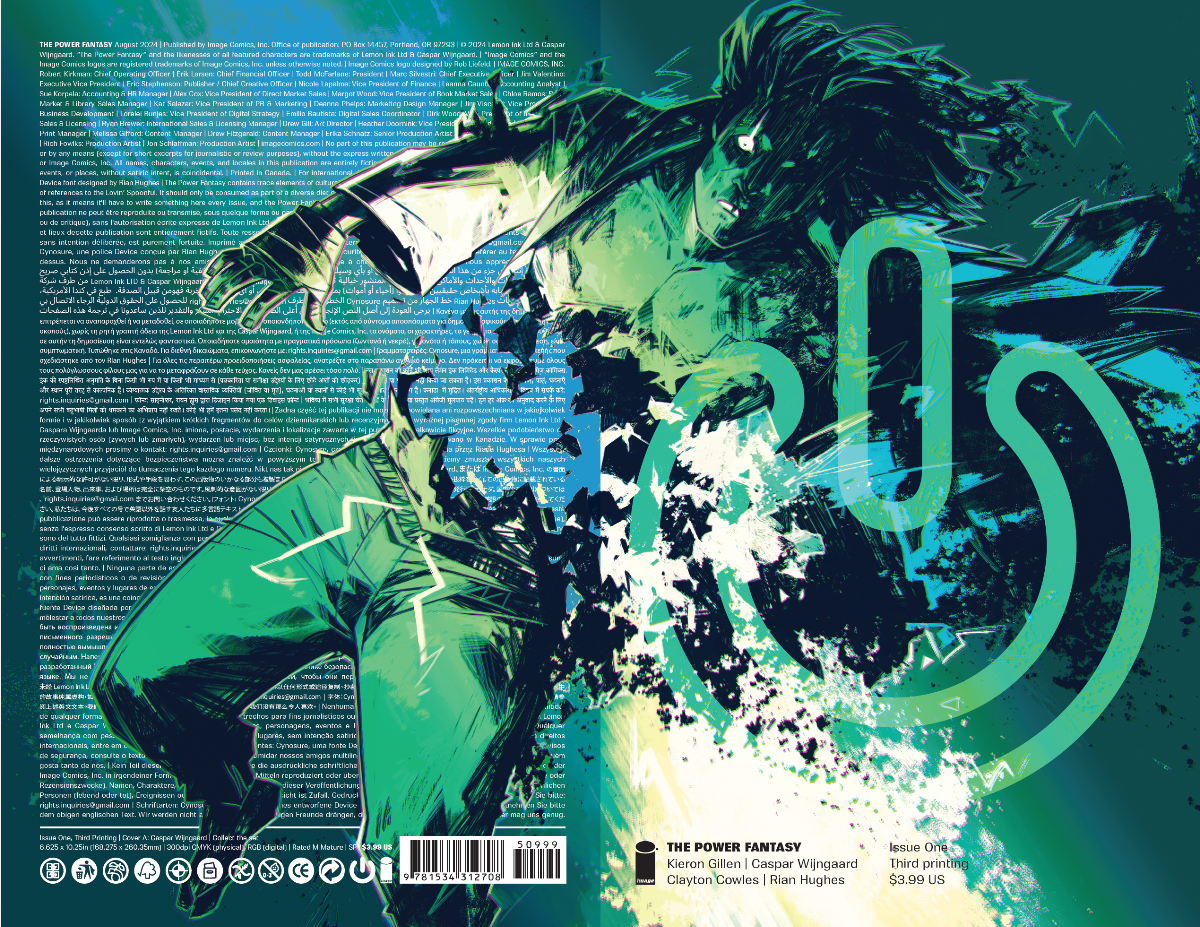
I want to talk about the other side of putting together a comic like this. I talked with Kelly Sue about this, so I want your perspective on it. This is your first creator-owned series launch since Die back in 2018, I believe. That was six years and another world ago. How different did it feel to launch a creator-owned book now versus then?
Kieron: There is another one, though. Ludocrats. I see why you forgot it. (laughs)
Was that 2019?
Kieron: That was going to come out the day of COVID when Diamond shut down. It was finally coming out on that day, which was April 1st.
So, what was different? It’s a weird market. It feels like a more conservative market.
It’s risk averse.
Kieron: It’s hard to get a read in my brain when it feels quite 2003. Like Transformers being as big as it was…the same thing happened when Dreamwave had it. There’s a lot of old licenses and nostalgia in the market. And as somebody whose work I like to think is anti-nostalgia as in, “Here’s something you haven’t seen.” I’m not always comfortable when the big books are like that.
I’m aware you have to work quite hard now, and I think the biggest problem, of course, is reaching people. The complete dissolution of social media…how can you even talk to people now?
Someone I know works in local libraries, and I hear about how folks stopped looking at noticeboards, as they expected to get all their news from Facebook… but now Facebook penalizes external links, so people don’t get the information they used to from it. But now they’ve been trained out of looking at noticeboards in real life. And even if they go to local libraries, they may not know stuff’s on, and they would’ve gone to it before lockdown, but now they need to relearn how to use the things around them.
That’s at least one reason I’m quite into trying to support the direct market as much as I can. The idea of a real-world structure where people actually go to places, see stuff, and have a community, etc., I think that’s the only way we rebuild. That’s the only way we get a flourishing ecosystem here. That’s one reason I’m doing the interview with Pornsak. Less image comics do house ads now, for example.
So that’s the downside of everything being an atomic unit. It means that there’s less the ebb and flow between creators. So, I thought it was important to create a thing which will point my readers in other directions. And then we’ve taken that advert, and we’ve allowed other Image creators to run it in their comics. A bunch of people have said they’re going to run the interview in there, so I’m going to do it in other ones and offer them to people. And if they’ve got a spare page or two, they can run something that’s better than a house ad.
As in, here is some actual bespoke content which will be useful and helps the Image creator support Image creators. All that kind of stuff is where my head’s at in terms of rebuilding connectivity. It feels like coming back after I’ve been away. I feel kind of bad. The reason why I stopped doing creator-owned was my brain was fried. After WicDiv led into Die, we had a baby, but it was quite a long and difficult journey to have Iris, then obviously COVID and Iris.
Basically, I took four years off creator-owned, so I feel kind of bad. This is the real work for me, and I feel I have to catch up. It’s not just re-establishing what we do. That’s what I feel. I wouldn’t say it’s like four lost years in my creative life because I’ve loved everything I’ve done, but I feel like we’re still sort of discovering what works in creator-owned now.
That’s something Kelly Sue and I talked about. It’s trying to figure out what works, but then also what does success even look like? How do you even determine that? Obviously, there’s the numbers, but when you’re building up to it, it feels like there’s a lot of interest in this book. But it feels like there’s a lot of people interested in all these titles that are coming up.
One thing I’ve found that has happened a lot lately is even with books that I’m interested in, I go to the comic shop and learn that it came out that week when I’m in the shop. And that’s me as a person who does an article every week where I look at the release list. And somehow it still escapes me.
Kieron: But the thing is we have a lot of stuff flying around in that way. But also the stuff with the shipping of the first issue was a problem and that of course pushed back the FOC 4 that changes everything down the line.
And then you have the second issue.
Kieron: Yeah, the second issue has a problem. So I think two thirds of the print run are coming out the week afterwards, and it’s like, “Well, that’s tiring.” Imagine just trying to explain that to readers to pop in. I’m kind of glad there are so many reprints of stuff flying around, because it may mean there’s at least some issues in the shop when new people come in.
Do you feel like your experience with The Power Fantasy has changed how you’re trying to promote We Called Them Giants, your upcoming graphic novel with Stephanie Hans?
Kieron: I have no idea. (David laughs) I’ve never done an OGN 5 before, so I feel in some ways worried that my attention is still on the kind of month-by-month thing.
Yeah, it’s a different species.
Kieron: Yeah. Whilst We Called Them Giants is a long game in that it’s already printed, so it won’t change the numbers that get printed. So, it’s a long game. It’ll come out and we’ll carry on. You’ll still get it. There’s a house ad in issue three. I’m just going to just carry on slowly pushing it, I guess. So, I’m still finding out what works with it. Because people have had the ARC 6 for six months. People who sign up for those services have the PDF, so people have been doing reviews for it for ages. But they’re not comic reviews. They’re people who are mainly in the book world.
I’m doing a shrug here. I dunno.
For a long time, one of the differences between the book market and the direct market was that the book market does repromotion, where the book isn’t dead as soon as the day after it comes out. You can get promoted three months later and an entirely different audience could discover it. I wonder if your experience with The Power Fantasy, where it hits the first print, sells out, hits the second print it sells out, and then get to do a third print…I wonder if that’s kind of what the model of success is going to look like, where the single-issue market is similar to the book market? Where it keeps building the further it goes along. That seems like it’s a harder way to do it, but also who the hell knows?
Kieron: Honestly, there’s a part of you that goes, “Man, couldn’t they just order another 50,000 copies to begin with and then we could just skip all the reprints?” (laughs)
But that’s super high risk for everybody.
Kieron: Exactly. Now, I say that jokingly in that way. But I’m quite enjoying the game of having something that’s selling out a lot and re-hyping it and working out what to do with covers. There’s part of me that quite enjoys this. It must be the part of me that used to work on magazines.
It gives you more bites of the promotional apple, for sure.
Kieron: Oh yeah. But the single bespoke object is also beautiful. I’m amazed that it took this far into my career to do an OGN. So I’m really interested when it’s out there, what happens? Because you say it’s something you can do tactics when it already exists. In fact, it’s easier because it’s a book you can just buy at any bookshop.
Long ago you had plans to roll out an imprint of books as part of your return to creator-owned comics, but you heard retailer Patrick Brower talk about where things were for comic shops on Off Panel. That led you to switch to your current plan. Now that you’re on your way through the new plan, are you happy you made that change?
Kieron: Definitely. I’ve barely got enough brain to do one book at the moment. (laughs) I think that would’ve been a mistake. I would’ve had to staff up and I’m not very good at staffing. We only finally got an actual full-time editor on The Power Fantasy on issue two. Katie West has jumped aboard, who is amazing. So, for all those reasons, hell yes. But yeah, honestly, I think in some ways I quite like the idea of just, “This is the book.”
I’ll say this…there’s a poster of Die they put out to advertise We Called Them Giants, and on the back is a Die backlist. At the bottom it says, “Die will return in 2025,” and I don’t think anyone’s noticed that yet.
I never noticed that.
Kieron: Exactly. No one did. So we’ve kind of said we’re going to do more Die. So that’s two things I’m kind of on the hook for.
Yeah, you’re making a lot of promises.
Kieron: It’s only three items or so at the moment. Annoyingly, in fact, I had an idea for a book last week that I really want to do, and it’s frustrating in that I need to find another artist, but that’ll be back end of next year at the earliest.
Or maybe I’ll just sleep, David.
I hope you do.
Thanks for reading this conversation with Kieron Gillen. If you enjoyed this interview and would like to read similar features about comics in the future, consider subscribing to SKTCHD for just that, and to support the work that I do.

